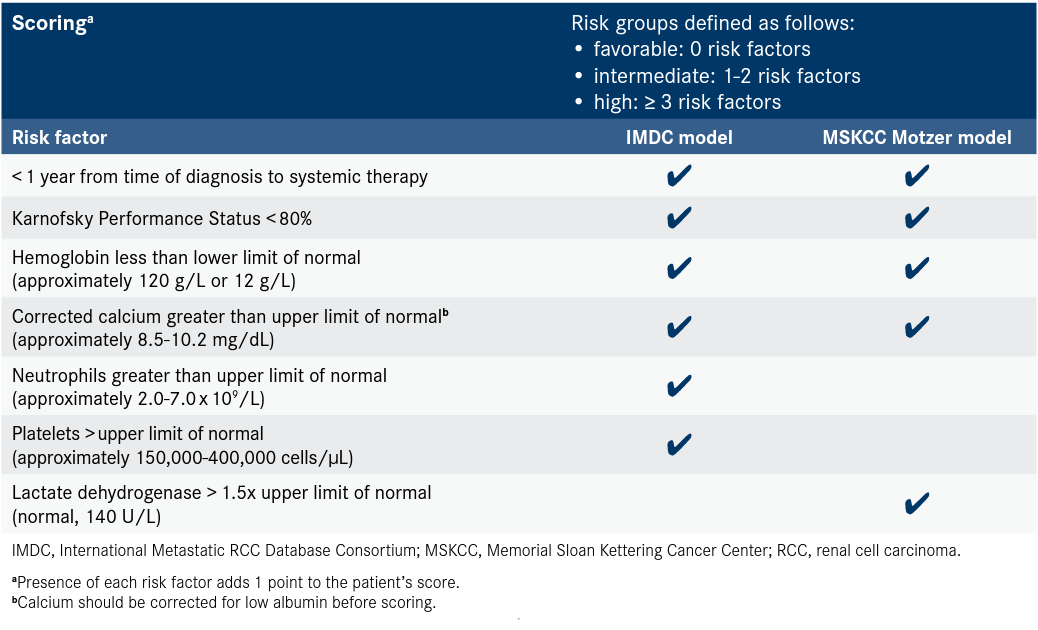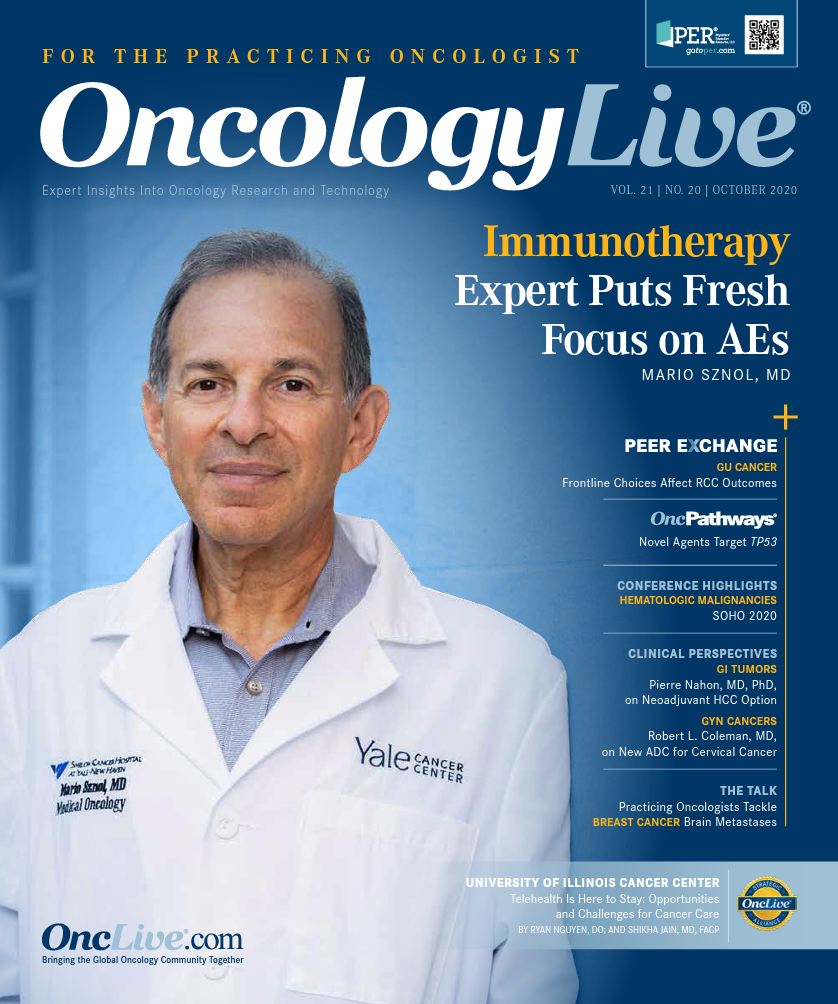Panelists Stress Importance of Putting Your Best Foot Forward in Advanced RCC
Kidney cancer experts emphasize the importance of risk stratification for guiding treatment decisions and discussed the clinical trials that have shaped the frontline treatment recommendations from the National Comprehensive Cancer Network for advanced clear cell RCC.
Daniel J. George, MD

Many patients with early-stage renal cell carcinoma (RCC) are cured, but the prognosis for those with advanced disease remains poor, with the 5-year survival ranging from 0% to 20%.1 Although the treatment armamentarium for advanced RCC has significantly expanded over the past few years, obtaining the best outcomes requires selecting the most efficacious treatment up front, as a substantial proportion of patients do not reach subsequent treatment lines.
During an OncLive Peer Exchange®, a panel of kidney cancer experts emphasized the importance of risk stratification for guiding treatment decisions and discussed the clinical trials that have shaped the frontline treatment recommendations from the National Comprehensive Cancer Network (NCCN) for advanced clear cell RCC. They shared their insights on how they select between these treatments to maximize their patients’ outcomes up front as well as on an exciting new combination therapy that is poised to add another powerful weapon to the treatment arsenal. “[I know] I have got to take that first best shot. If patients don’t tolerate something, then I can dial it back, but we may not get a chance to do some fantastic salvage regimen if they don’t get some disease reduction in this first-line setting,” moderator Daniel J. George, MD, said. “For these patients, making the first best decision is critical,” he emphasized.
Risk Stratification
Several validated risk-stratification models can be used in clinical practice to stratify patients with advanced RCC, including the International Metastatic RCC Database Consortium (IMDC) model and the Memorial Sloan Kettering Cancer Center (MSKCC) Motzer criteria (Table 1).2,3 “The IMDC criteria were initially validated in the context of the VEGF-targeted therapy era. Predating that were the MSKCC Motzer criteria that were validated in the cytokine era,” Rana R. McKay, MD, said.
Rana R. McKay, MD

The panelists emphasized the importance of using such tools for risk stratification in every patient with metastatic RCC. “When we talk with our colleagues in the community, they sometimes suggest that they might be using a gestalt impression of whether a patient is good risk, intermediate risk, or poor risk. Now that we understand the biological underpinnings of what good, intermediate, and poor is, I am sticking to the criteria more directly. I have to say, it’s been a long time since I’ve not staged a patient with IMDC risk characteristics,” Sumanta Kumar Pal, MD, said.
McKay explained that patients with favorable risk tend to have a higher expression of angiogenesis-related genes and may benefit from VEGF inhibition, whereas those with intermediate and poor risk tend to show a more upregulated immune signature. “The application of these risk stratifications is critically important not just in determining systemic therapy but in thinking about the role of cytoreductive nephrectomy,” she said.
Although the IMDC and MSKCC Motzer models give each risk factor equal weight (Table 12,3), Neeraj Agarwal, MD, said he pays most attention to time from original localized kidney cancer and nephrectomy to time of onset of metastatic disease. “If a patient is developing metastatic disease within 4 or 5 months from nephrectomy, that’s a bad sign. If I see someone who is coming to me 8 years after their original nephrectomy, it’s a different disease,” he said. George concurred, noting that it is the only risk factor that “speaks to the natural history of the disease,” whereas the others may be attributable to a variety of other factors. “There are a lot of factors that affect anemia. Even hypercalcemia could be due to dietary, sedentary, or other factors. Performance status is definitely affected by a lot of factors in the patient,” he said.
Table 1. IMDC and MSKCC Motzer Models in Risk Stratification of Metastatic RCC2,3

Key Clinical Trials Shaping NCCN Treatment Recommendations
The panelists proceeded to discuss some of the NCCN recommended frontline treatments (Table 24), particularly how they decide whether to proceed with a VEGF receptor–tyrosine kinase inhibitor (TKI) alone or in combination with immunotherapy or with immunotherapy alone. VEGF/TKI plus immunotherapy options recommended by the NCCN include axitinib (Inlyta)/pembrolizumab (Keytruda), which the FDA approved in April 2019 based on data from the phase 3 KEYNOTE-426 (NCT02853331) study, and axitinib/avelumab (Bavencio), approved in May 2019 based on the phase 3 JAVELIN Renal 101 (NCT02684006) trial.5,6 The recommended immunotherapy is nivolumab (Opdivo)/ipilimumab (Yervoy), which the FDA approved in April 2018 for previously untreated patients with intermediate- or poor-risk advanced RCC based on data from the phase 3 CheckMate 214 (NCT02231749) trial.7
Table 2. NCCN-Recommended First-Line Therapy for RCC With Clear Cell Histology Based on Patient Risk Profile4a
The NCCN’s preferred VEGF/TKI mono-therapies include pazopanib (Votrient) or sunitinib (Sutent) for patients with favor-able risk, and cabozantinib (Cabometyx) for those with intermediate or poor risk, with the latter recommendation based on the phase 2 CABOSUN (NCT01835158) study. Cabozantinib was approved in December 2017 as a first-line treatment for patients with advanced RCC, regardless of risk profile.8
KEYNOTE-426: Axitinib/Pembrolizumab
KEYNOTE-426 randomly assigned 861 patients who had not received systemic therapy for advanced RCC to receive pembrolizumab 200 mg intravenously every 3 weeks in combination with axitinib 5 mg orally twice daily (n = 432), or sunitinib 50 mg orally once daily for 4 weeks followed by 2 weeks off (n = 429).9 After a median follow-up of 12.8 months, an estimated 89.9% of patients in the combination therapy arm were still alive at 12 months compared with 78.3% in the sunitinib arm (HR for death, 0.53; 95% CI, 0.38-0.74; P < .0001). The median progression-free survival (PFS) was 15.1 months in the combination therapy arm and 11.1 months in the sunitinib arm (HR for progression or death, 0.69; 95% CI, 0.57-0.84; P < .001), whereas the objective response rate (ORR) was 59.3% and 35.7% in these cohorts, respectively (P < .001).
Sumanta Kumar Pal, MD

“You see a benefit in overall survival in the overarching cohort and certainly a benefit in response rate and progression-free survival across a stratum,” Pal said. The study included patients from all risk groups and those with and without PD-L1 expression.
JAVELIN Renal 101: Axitinib/Avelumab
JAVELIN Renal 101 randomly assigned 886 patients to receive avelumab 10 mg/kg intravenously every 2 weeks in combination with axitinib 5 mg orally twice daily (n = 442), or sunitinib 50 mg orally once daily for 4 weeks and then 2 weeks off (n = 444).10 The median PFS with the combination therapy was 13.8 months in both the overall study population and the subset of patients with PD-L1–positive tumors, whereas the median PFS with sunitinib was 7.2 months in the PD-L1–positive cohort (HR for disease progression or death, 0.61; 95% CI, 0.47-0.79; P < .001) and 8.4 months in the overall study population (HR, 0.69; 95% CI, 0.56-0.84; P < .001).10
“The study showed a benefit in progression-free survival across a stratum, but it failed to show an improvement, at least to date, in overall survival,” Pal said. Updated efficacy results from the second interim analysis of JAVELIN Renal 101 were published in August 2020.11 Although these showed continued statistically significant improvement in PFS with avelumab/axitinib over sunitinib, the OS data remained immature. The PD-L1–positive cohort had an HR of 0.828 (95% CI, 0.596-1.151; 1-sided P = .1301) and the overall population had an HR of 0.796 (95% CI, 0.616-1.027; 1-sided P = .0392).11
In September 2020, the JAVELIN Renal 101 investigators published the results of their molecular analysis of the 886 baseline tumor samples, which confirmed no difference in PFS based on PD-L1 status.12 Tumor mutational burden and the presence of FcɣR single nucleotide polymorphisms also did not affect outcomes; however, investigators found that several biological features were associated with the different PFS between treatment arms, including new immunomodulatory and angiogenesis gene expression signatures, previously undescribed mutational profiles and their gene expression signatures, and several human leukocyte antigen types. The investigators noted that their findings may facilitate the development of more effective treatment strategies in patients with clear cell RCC.12
During the Peer Exchange, the panelists emphasized the need for identifying meaningful biomarkers in patients with clear cell RCC. George noted that PD-L1 status is one biomarker that is commonly assessed for and asked the panelists if they use it to guide their treatment decision-making. The consensus was that whereas it might help with prognostication it does not play a role in treatment selection. “People who are PD-L1–positive seem to do worse compared with people who are not…. It may be that the responses are going to be higher in patients who are PD-L1–positive, but patients who are PD-L1–negative can respond. It’s not a pure biomarker. You’re not going to restrict therapy around PD-L1 status,” McKay said. She noted that although the biomarker assessments that JAVELIN Renal 101 and CheckMate 214 investigators had conducted were “elegant,”12,13 there was a lack of consistency between studies in assessing biomarkers. “[We need to] integrate the same biomarker panel across these trials so we can learn something and try to better select our patients beyond just IMDC criteria,” she said.
CheckMate 214: Nivolumab/Ipilimumab
The extended follow-up of the CheckMate 214 trial included 1096 patients who were randomly assigned to receive nivolumab/ipilimumab (n = 550) or sunitinib (n = 546).14 Of the patients in the immunotherapy arm, 425 were intermediate or poor risk and 125 were favorable risk, whereas in the sunitinib arm, 422 patients were intermediate or poor risk and 124 were favorable risk. After a median follow-up of 32.4 months, the immunotherapy combination continued to show superiority over sunitinib in OS among the intermediate- and poor-risk patients (median not reached vs 26.6 months [HR, 0.66; 95% CI, 0.54-0.80; P < .0001]) and among the intention-to-treat (ITT) patients (median not reached vs 37.9 months [HR, 0.71; 95% CI, 0.59-0.86; P = .0003]). Benefit in PFS and ORR was also reported across cohorts. More recently, follow-up to 42 months showed sustained superiority with nivolumab/ipilimumab across cohorts in OS and ORR compared with sunitinib.15
“A longer follow-up is always compelling for me, especially when I’m looking at the durability of complete response, which is the first thing that comes to my mind when I think about ipilimumab/nivolumab. A 42-month follow-up is a big deal, and it continues to reinforce that this regimen induces those durable complete responses,” Agarwal said.
Neeraj Agarwal, MD

Among the ITT population, a CR occurred in 11% of the immunotherapy-treated patients versus 2% of the sunitinib-treated patients, and in the intermediate- and poor-risk patients, CR occurred in 10% of immunotherapy-treated patients and 1% of the sunitinib-treated patients.15 When asked how he defines a CR, Agarwal said as long as he sees the dominant lesions decreasing in size by greater than 90%, he considers it a CR.
Long-term follow-up data from CheckMate 214 presented at the European Society for Medical Oncology Virtual Congress 2020 showed that in the ITT population, nivolumab plus ipilimumab continued to outperform sunitinib (HR, 0.69; 95% CI, 0.59-0.81). The doublet improved survival in patients with intermediate- or poor-risk disease (HR, 0.69; 95% CI, 0.54-0.78), and responses remained deep and durable regardless of IMDC risk-based prognosis.16
CABOSUN: Cabozantinib
CABOSUN randomly assigned 157 patients with intermediate- or poor-risk clear cell RCC by IMDC criteria to cabozantinib 60 mg daily (n = 79) or sunitinib 50 mg daily for 4 weeks followed by 2 weeks off (n = 78).17 The median PFS by independent review committee (IRC) was 8.6 months for cabozantinib versus 5.3 months for sunitinib (HR, 0.48; 95% CI, 0.31-0.74; 2-sided P = .0008), and the ORR per IRC was 20% versus 9% in these groups, respectively. After a median follow-up of 34.5 months, the median OS was 26.6 months in the cabozantinib arm and 21.2 months in the sunitinib arm (HR, 0.80; 95% CI, 0.53-1.21).
“We were one of the first studies to look at the intermediate- and poor-risk populations and show a difference in TKIs, that maybe not all TKIs are the same and that cabozantinib showed some progression-free survival superiority over sunitinib in that frontline setting,” George said.
Putting the Clinical Trial Data Into PracticeThe panelists proceeded to discuss the importance of using the best treatments up front. “Some studies, like the IMDC data sets, reflect how just 50% of patients make it to second-line treatment. Those numbers may be a bit better Putting the Clinical Trial Data Into PracticeThe panelists proceeded to discuss the importance of using the best treatments up front. “Some studies, like the IMDC data sets, reflect how just 50% of patients make it to second-line treatment. Those numbers may be a bit better
Putting the Clinical Trial Data Into Practice
The panelists proceeded to discuss the importance of using the best treatments up front. “Some studies, like the IMDC data sets, reflect how just 50% of patients make it to second-line treatment. Those numbers may be a bit better in the context of VEGF and [immunotherapy], but we just don’t know yet at this point. I would suggest that means you can’t save the best for last here; you’ve got to put your best foot forward right up front,” Pal said.
George concurred, noting that he is especially concerned there won’t be an opportunity for second-line treatment in the setting of symptomatic bone metastasis, high tumor burden, and disconcerting symptoms such as pain and weight loss, the latter of which he said is really muscle loss. “When you lose muscle, it makes everything that much tougher to tolerate and [limits your ability] to get to your second or third line of therapy,” he said.
Agarwal said that favorable-risk patients are a bit more challenging to treat because there can be significant variation among them. He remarked that this population can include patients with a single metastatic nodule that is not active as well as patients with multiple sites of metastasis and relatively high disease burden but with normal lab findings. Subsequently, he bases his treatment approach on disease volume in these patients. For those with low disease volume, Agarwal said he prefers active surveillance because treatments may cause more harm than good in such patients. “For just 1 or 2 sites of metastasis that are slowly growing, and when the patient is otherwise doing well, it’s single-agent VEGF/TKI,” he said. He said this can include pazopanib and sunitinib, but that he also considers the CABOSUN trial data. “Cabozantinib was superior to sunitinib, so I don’t hesitate to pick up cabozantinib Agarwal said that favorable-risk patients are a bit more challenging to treat because there can be significant variation among them. He remarked that this population can include patients with a single metastatic nodule that is not active as well as patients with multiple sites of metastasis and relatively high disease burden but with normal lab findings. Subsequently, he bases his treatment approach on disease volume in these patients. For those with low disease volume, Agarwal said he prefers active surveillance because treatments may cause more harm than good in such patients. “For just 1 or 2 sites of metastasis that are slowly growing, and when the patient is otherwise doing well, it’s single-agent VEGF/TKI,” he said. He said this can include pazopanib and sunitinib, but that he also considers the CABOSUN trial data. “Cabozantinib was superior to sunitinib, so I don’t hesitate to pick up cabozantinib as a VEGF/TKI of choice for these patients,” he said. In patients with more rapidly progressing disease, but who are still in the favorable-risk category, he tends to pick up axitinib/pembrolizumab.
Another important factor in treatment decision-making the panelists discussed is the need to account for patient factors, including age, fitness level, and goals. “You may have a favorable-risk patient who is young and healthy, and although they’re a favorable risk, you still may be swayed to use an IO/ IO [immuno-oncology] combination for that individual. You may [also] have a poor-risk patient who may be older and doesn’t want to come in and get IV [intravenous] treatment; they live far away from the center, they have other comorbidities, and you’re going to say, ‘You know what, we’re just going to do cabozantinib for you based on the CABOSUN trial data,’ ” McKay said. She pointed out that although it is important to understand and apply clinical trial data, “there’s a lot of gray and art” in treatment decision-making.
New Regimen on the Horizon: Nivolumab + Cabozantinib
A new combination that has generated considerable excitement among the panelists is nivolumab plus cabozantinib, currently being studied in the phase 3 CheckMate 9ER trial (NCT03141177). Topline results showed that the combination not only significantly improved OS but also doubled PFS and response rates compared with sunitinib, prompting CheckMate 9ER to meet all efficacy end points.18,19 The OS, PFS, and ORR advantages were consistently seen across IMDC risk status, PD-L1 expression, and bone metastases.19
Specifically, the doublet therapy reduced the risk of death or disease progression by 49%. The secondary end point of median overall survival was not reached in either arm, but risk of death was reduced by 40%. At a median follow-up of 10.6 months, the median OS was not reached in either treatment arm (HR, 0.60; 98.89% CI, 0.40-0.89; P = .0010). The median PFS, also evaluated at 10.6 months, was 16.6 months with the 2-drug approach versus 8.3 months with sunitinib (HR, 0.51; 95% CI, 0.41-0.64; P < .0001). The ORR was 55.7% with nivolumab and cabozantinib and 27.1% with sunitinib.19
“My sense was that, after bevacizumab/ atezolizumab came out, all the VEGF/IO regimens to emerge thereafter would face an uphill battle. If you’re competing against sunitinib, you’re going to have more and more patients who get a VEGF inhibitor up front, cross over, and get second-line immunotherapy, then that would certainly make an overall survival bar even higher. Seeing CheckMate 9ER emerge with this impressive signal for OS and PFS advantage is incredible,” Pal said. He also said that he already has settings in which he would preferentially use this regimen, despite there not yet being substantial follow-up. “[I would use it] for those patients with bone metastasis and those patients with aggressive disease that were cast under the CABOSUN trial umbrella,” he said.
Based on the CheckMate 9ER data, a supplemental new drug application has been filed with the FDA for cabozantinib/nivolumab in patients with previously untreated advanced RCC.20 This is the first regulatory submission for cabozantinib in combination with an immune checkpoint inhibitor.
- Kalra S, Atkinson BJ, Matrana MR, et al. Prognosis of patients with metastatic renal cell carcinoma and pancreatic metastases. BJU Int. 2016;117(5):761-765. doi:10.1111/bju.13185
- IMDC (International Metastatic RCC Database Consortium) risk model for metastatic renal cell carcinoma. MDCalc. Accessed September 14, 2020. https://bit.ly/3n4wb0Q
- Memorial Sloan Kettering Cancer Center (MSKCC/Motzer) score for metastatic renal cell carcinoma (RCC). MDCalc. Accessed September 14, 2020. https://bit.ly/33dldhZ
- NCCN. Clinical Practice Guidelines in Oncology. Kidney cancer, version 1.2021. Accessed September 14, 2020. https://bit.ly/3cF6UG1
- FDA approves pembrolizumab plus axitinib for advanced renal cell carcinoma. News release. FDA. Updated April 22, 2019. Accessed September 14, 2020. https://bit.ly/32rHPKY
- FDA approves avelumab plus axitinib for renal cell carcinoma. News release. FDA. Updated May 15, 2019. Accessed September 14, 2020. https://bit.ly/35C2azs
- FDA approves nivolumab plus ipilimumab combination for intermediate or poor-risk advanced renal cell carcinoma. News release. FDA. April 16, 2018. Accessed September 14, 2020. https://bit.ly/2H1tc95
- FDA grants regular approval to Cabometyx for first-line treatment of advanced renal cell carcinoma. News release. FDA. December 19, 2017. Accessed September 14, 2020. https://bit.ly/35AbvYh
- Rini BI, Plimack ER, Stus V, et al; KEYNOTE-426 Investigators. Pembrolizumab plus axitinib versus sunitinib for advanced renal-cell carcinoma. N Engl J Med. 2019;380(12):1116-1127. doi:10.1056/NEJMoa1816714
- Motzer RJ, Penkov K, Haanen J, et al. Avelumab plus axitinib versus sunitinib for advanced renal-cell carcinoma. N Engl J Med. 2019;380(12):1103-1115. doi:10.1056/NEJMoa1816047
- Choueiri TK, Motzer RJ, Rini BI, et al. Updated efficacy results from the JAVELIN Renal 101 trial: first-line avelumab plus axitinib versus sunitinib in patients with advanced renal cell carcinoma. Ann Oncol. 2020;31(8):1030-1039. doi:10.1016/j.annonc.2020.04.010
- Motzer RJ, Robbins PB, Powles T, et al. Avelumab plus axitinib versus sunitinib in advanced renal cell carcinoma: biomarker analysis of the phase 3 JAVELIN Renal 101 trial. Nat Med. Published online September 7, 2020. doi:10.1038/s41591-020-1044-8
- Motzer RJ, Choueiri TK, McDermott DF, et al. Biomarker analyses from the phase III CheckMate 214 trial of nivolumab plus ipilimumab (N+I) or sunitinib (S) in advanced renal cell carcinoma (aRCC). J Clin Oncol. 2020;38(suppl 15):5009. doi:10.1200/JCO.2020.38.15_suppl.5009
- Motzer RJ, Rini BI, McDermott DF, et al; CheckMate 124 Investigators. Nivolumab plus ipilimumab versus sunitinib in first-line treatment for advanced renal cell carcinoma: extended follow-up of efficacy and safety results from a randomised, controlled, phase 3 trial. Lancet Oncol. 2019;20(10):1370-1385. doi:10.1016/S1470-2045(19)30413-9
- Tannir NM, McDermott DF, Escudier B, et al. Overall survival and independent review of response in CheckMate 214 with 42-month follow-up: first-line nivolumab + ipilimumab (N+I) versus sunitinib (S) in patients (pts) with advanced renal cell carcinoma (aRCC). J Clin Oncol. 2020;38(suppl 6):609. doi:10.1200/JCO.2020.38.6_suppl.609
- Choueiri TK, Hessel C, Halabi S, et al. Cabozantinib versus sunitinib as initial therapy for metastatic renal cell carcinoma of intermediate or poor risk (Alliance A031203 CABOSUN randomised trial): progression-free survival by independent review and overall survival update. Eur J Cancer. 2018;94:115-125. doi:10.1016/j.ejca.2018.02.012
- Albiges L, Tannir N, Burotto M, et al. 711P Nivolumab + ipilimumab (N+I) vs sunitinib (S) for first-line treatment of advanced renal cell carcinoma (aRCC) in CheckMate 214: 4-year follow-up and subgroup analysis of patients (pts) without nephrectomy. Ann Oncol. 2020;31(suppl 4):S559-S560. doi:10.1016/j.annonc.2020.08.783
- Bristol Myers Squibb and Exelixis announce positive topline results from pivotal phase 3 CheckMate --9ER trial evaluating Opdivo (nivolumab) in combination with Cabometyx (cabozantinib) in previously untreated advanced renal cell carcinoma. News release. Bristol Myers Squibb. April 20, 2020. Accessed September 15, 2020. https://bit.ly/35DUrAI
- Choueiri TK, Powles T, Burotto M, et al. Nivolumab + cabozantinib vs sunitinib in first-line treatment for advanced renal cell carcinoma: first results from the randomized phase III CheckMate 9ER trial. Ann Oncol. 2020;31(suppl 4):S1142-S1215. doi:10.1016/annonc/annonc325
- Exelixis announces submission of supplemental new drug application to U.S. Food and Drug Administration for Cabometyx (cabozantinib) in combination with Opdivo (nivolumab) for advanced renal cell carcinoma. News release. Exelixis, Inc. August 24, 2020. Accessed September 14, 2020. https://bit.ly/347gzRL




